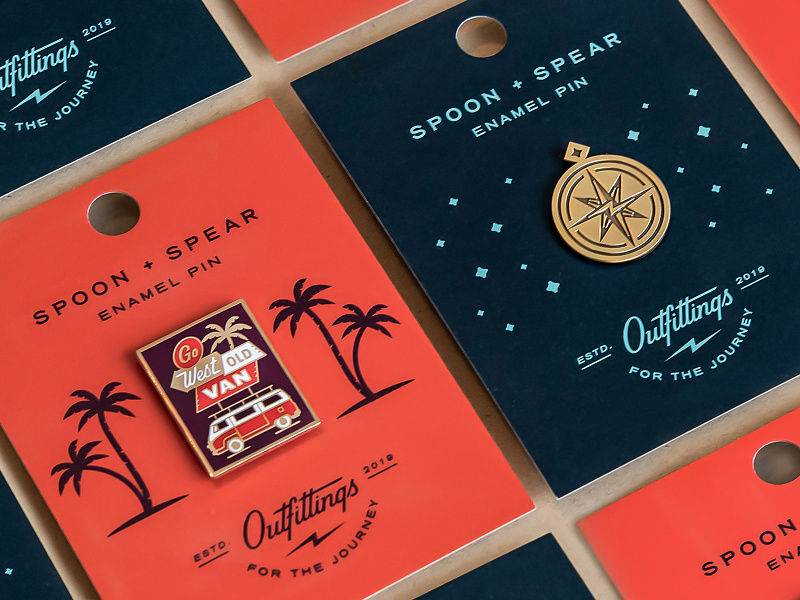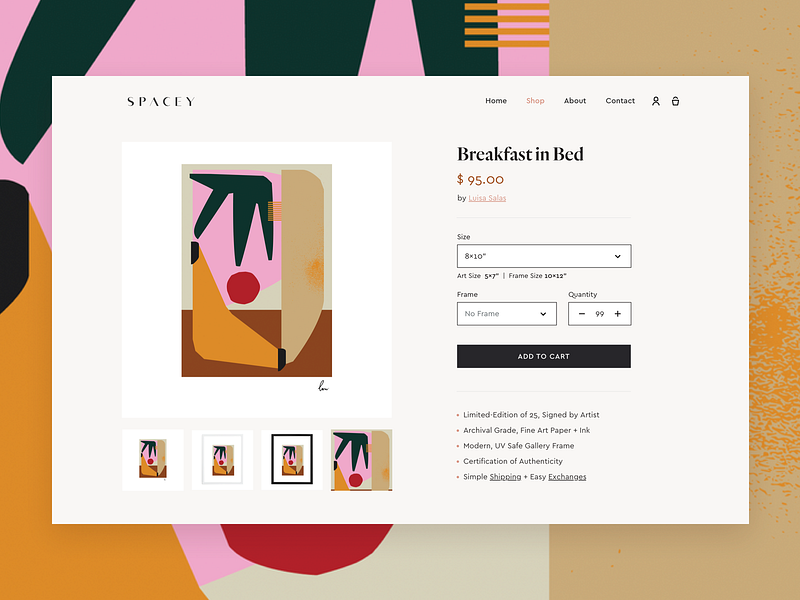In this post, Darya Jandossova Troncoso explains the many different avenues to sell your art online, plus how to stand out against the thousands of other creators doing the same.
Making money with your art can feel like a daunting task. Like most, you may have considered it before but were unsure of how to proceed. Or, maybe the fear of being rejected, ignored, or simply misunderstood hindered you from starting.
But as a creator in the 21st century, there are more options than ever for showcasing and selling your work. It’s all about figuring out which avenues work best for you and also feel authentic to your craft. If you’re ready to start exploring the different ways to sell your art online, let’s dive right in.
Row 1: Spoon & Spear, Dani Rayne, Graphics Collection.
Social media strategies
It’s hard to find creators these days who don’t have a social presence, and there’s a good reason why. Social media platforms like Dribbble, Instagram, Pinterest, and Facebook are great channels to showcase your art to many.
But before setting up your social profiles and adding all of your artwork, figure out your marketing strategy first. Because whether you like it or not, you’ll have to do quite a bit of marketing work in order to make sales. Here are a few suggestions to start off:
- Create separate accounts: Don’t try to sell your artwork from your personal account. Mixing business with personal posts is not ideal.
- Upload your art: If it’s digital, add the digital files. If it’s on a canvas or a print, take good quality, well-lit photos . Basically, take some time to stage your art before you photograph and upload it.
- Take time to craft your posts: This means writing an engaging caption, using the right hashtags (between 3 - 8 for Instagram), and tags that include your medium, location, style, and so on. You’ll be easier to find this way.
- Set your price: Figure out how much you’re willing to sell your art for and don’t budge. You’ve spent countless hours gaining the skills and expertise so don’t undersell yourself.
- Build your following: There are a variety of ways to go about this one. It could be anything from influencer collaborations to asking your friends to share your account and your art. This great guide talks more in-depth about how to get started on Instagram.
- Engage with your audience: Be nice, answer comments, engage in conversations, and say thank you!
- Figure out how you’ll ship & sell your art (if it’s not digital) and how you’ll get paid. An easy way to do this is to use something like an art commission form template that takes care of accepting payments online and more.
This is quite a bit to wrap your head around, so take it step by step, and don’t get too overwhelmed!
Online art portals
Outside of social media, you can also check out an extensive list of sites where you can sell your art online . It’s best practice to try out several places since tying yourself down to one platform means less exposure.
However, there are a few caveats if you decide to go in this direction—one of them being the simple fact that your art can get lost among thousands of pieces. If you’re not an already established artist, it might make sense to build up a following on social media first, and then move on to a portal if you still want to.
One perk about selling your art through these platforms though, is the fact that many online portals will take care of printing and shipping so you can just focus on creating.
Blogging
Blogging is a great way to tell your story, and while you can still do that on social media, having a blog or a website where you talk at greater lengths about your art, your process, and your inspiration is a valuable addition.
You could go a step further and set up your own e-commerce store where you sell your art. In this case, you’ll need to figure out printing , shipping , creating contracts, and so on. Again, it’s not a deterrent, just something to keep in mind.
Blogging can be a bit complicated for newbies since it’s not just about writing an article and posting it. You have to consider SEO (search engine optimization), your CMS (content management system), and what topics you’ll actually be writing about. So having something like a content calendar can help you out significantly.
With a blog or a website, you can create long-form content such as tutorials, articles, interviews, or online courses—this means more ways to share what you do and how you do it. And if you have a large audience on another social platform, there’s a good chance your followers will gravitate towards the other content you produce as well, learning more about you as an artist along the way.
When you also run a blog or manage your own website, it adds to your credibility as an artist. So if it’s a career you want to continue pursuing, investing time and resources early on makes sense. Either way, don’t dismiss blogging because if anything, it’s a great addition to your social media profiles.
Wrapping up
There isn’t one single right way to sell your art online. In fact, there are plenty of options, and trying out different methods will help you figure out what you prefer, open you up to new opportunities, and introduce you to new audiences and experiences. The initial steps might be daunting if you’re not social media savvy, or you’ve never blogged before. Most likely it’ll be a slow process with a bit of a learning curve but don’t let that discourage you!
Perseverance and occasional failure will not only make you a stronger person, but it could impact your art in ways you couldn’t previously imagine. As the great Henri Matisse once said, “Creativity takes courage”, and with enough courage, the world is your oyster ■
About the author: Darya Jandossova Troncoso is a photographer, artist, and writer working on her first novel and managing two digital marketing blogs—MarketTap and MarketSplash. In her spare time, she enjoys spending time with her family, cooking, and creating art.
RELATED READING:
- How this designer turned her online shop into a full‑time job
- Making merch on the side: 5 tips for getting started
- How to design your online shop like a pro
Find more Process stories on our blog Courtside. Have a suggestion? Contact stories@dribbble.com.














